Financial Decision Making
VerifiedAdded on 2023/01/18
|14
|4456
|64
AI Summary
This report studies the financial performance of Roast Ltd and analyzes whether Starbucks should acquire the company. It evaluates the income statement, balance sheet, and cash flow. It also discusses investment appraisal techniques and sources of finance.
Contribute Materials
Your contribution can guide someone’s learning journey. Share your
documents today.
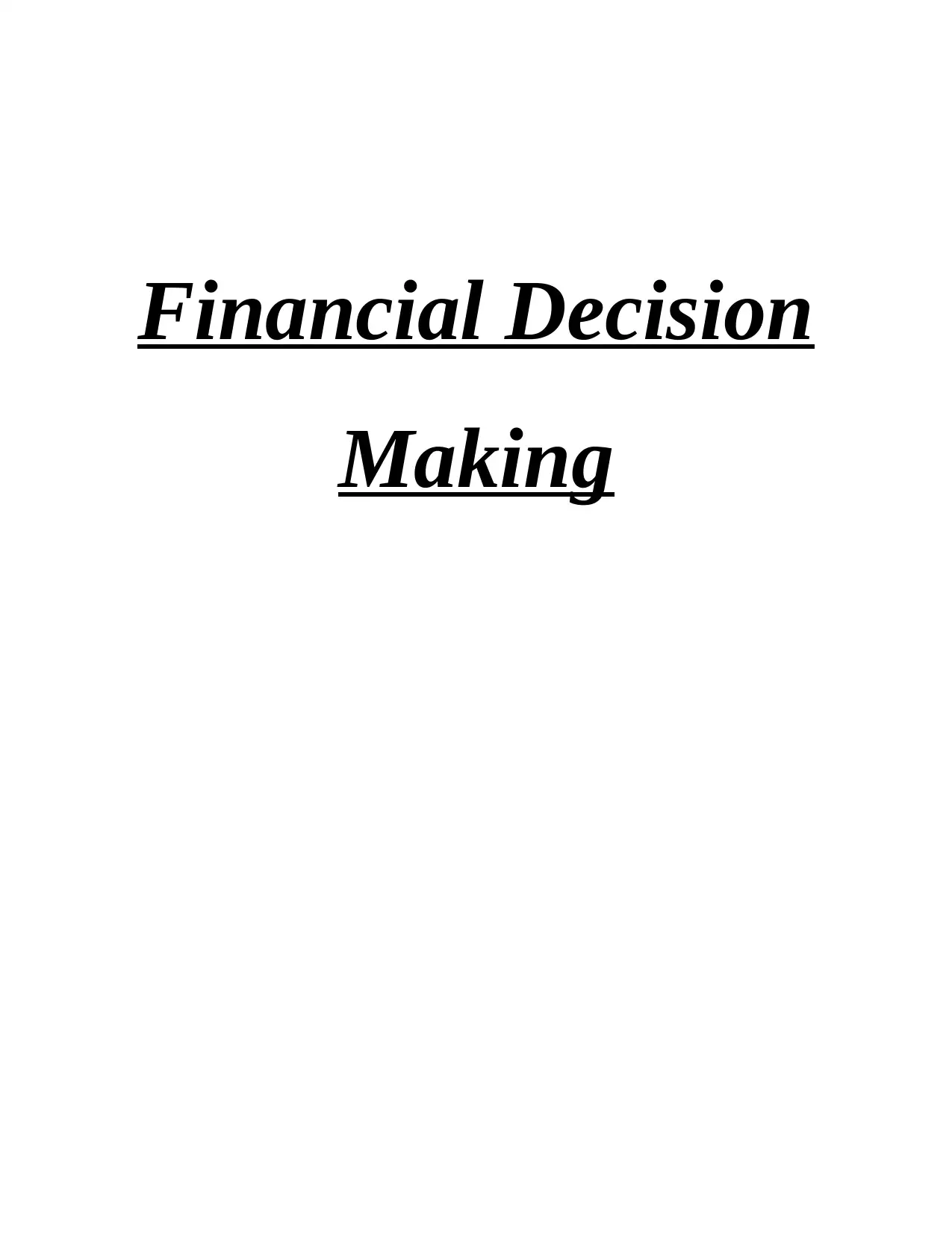
Financial Decision
Making
Making
Secure Best Marks with AI Grader
Need help grading? Try our AI Grader for instant feedback on your assignments.

Table of Contents
EXECUTIVE SUMMARY.............................................................................................................3
MAIN BODY...................................................................................................................................3
PART 1- Industry Overview ..........................................................................................................3
PART 2 – Business Performance Analysis......................................................................................4
2.1 Statement of Profit & Loss....................................................................................................4
2.2 Statement of Financial Position.............................................................................................6
2.3 Statement of Cash Flow.........................................................................................................8
PART 3 – Investment Appraisal......................................................................................................9
3.1.a Management Forecast.........................................................................................................9
3.1.b Investment Appraisal Technique......................................................................................10
3.2 Sources of Finance...............................................................................................................11
.....................................................................................................................................................12
REFERENCES .............................................................................................................................13
EXECUTIVE SUMMARY.............................................................................................................3
MAIN BODY...................................................................................................................................3
PART 1- Industry Overview ..........................................................................................................3
PART 2 – Business Performance Analysis......................................................................................4
2.1 Statement of Profit & Loss....................................................................................................4
2.2 Statement of Financial Position.............................................................................................6
2.3 Statement of Cash Flow.........................................................................................................8
PART 3 – Investment Appraisal......................................................................................................9
3.1.a Management Forecast.........................................................................................................9
3.1.b Investment Appraisal Technique......................................................................................10
3.2 Sources of Finance...............................................................................................................11
.....................................................................................................................................................12
REFERENCES .............................................................................................................................13
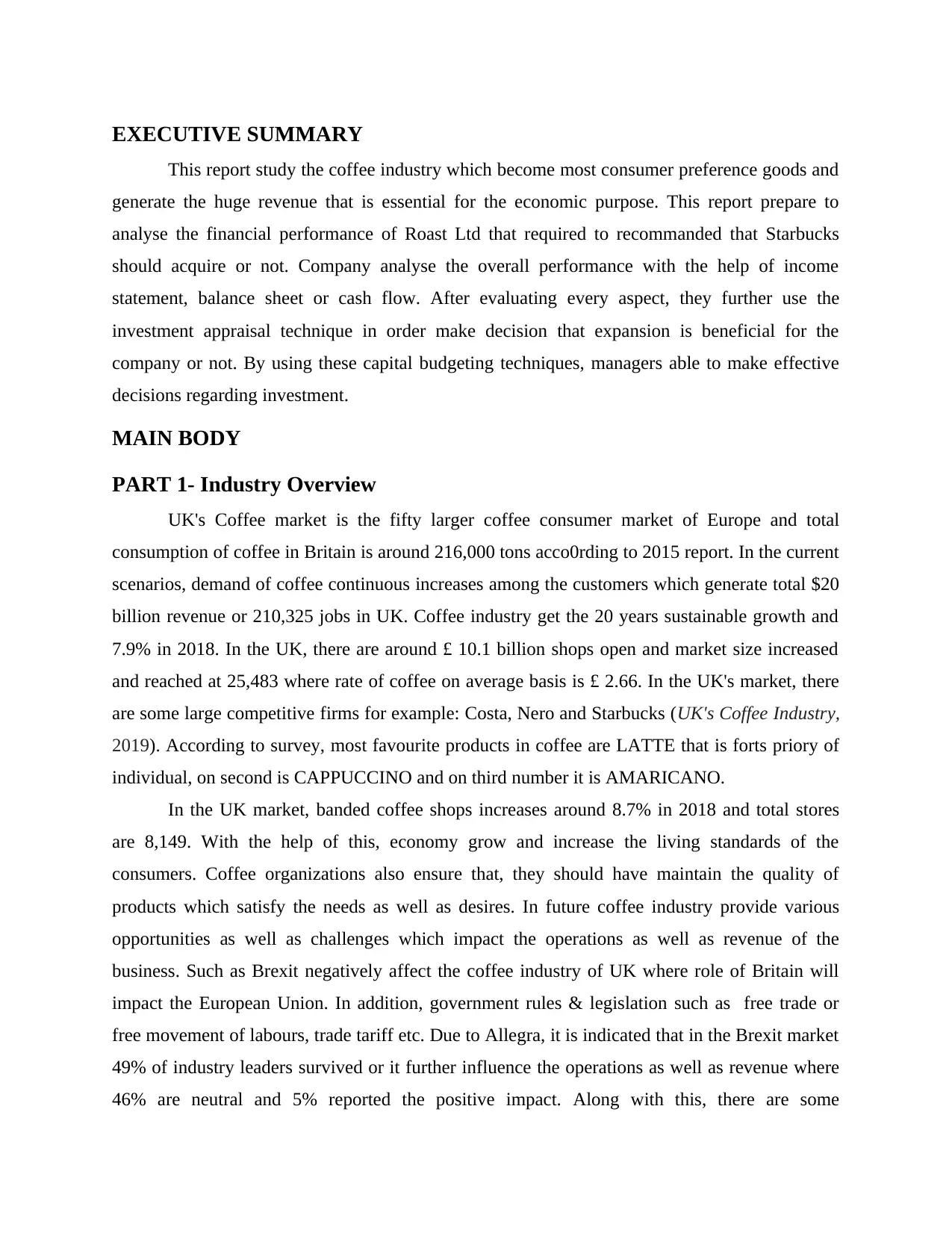
EXECUTIVE SUMMARY
This report study the coffee industry which become most consumer preference goods and
generate the huge revenue that is essential for the economic purpose. This report prepare to
analyse the financial performance of Roast Ltd that required to recommanded that Starbucks
should acquire or not. Company analyse the overall performance with the help of income
statement, balance sheet or cash flow. After evaluating every aspect, they further use the
investment appraisal technique in order make decision that expansion is beneficial for the
company or not. By using these capital budgeting techniques, managers able to make effective
decisions regarding investment.
MAIN BODY
PART 1- Industry Overview
UK's Coffee market is the fifty larger coffee consumer market of Europe and total
consumption of coffee in Britain is around 216,000 tons acco0rding to 2015 report. In the current
scenarios, demand of coffee continuous increases among the customers which generate total $20
billion revenue or 210,325 jobs in UK. Coffee industry get the 20 years sustainable growth and
7.9% in 2018. In the UK, there are around £ 10.1 billion shops open and market size increased
and reached at 25,483 where rate of coffee on average basis is £ 2.66. In the UK's market, there
are some large competitive firms for example: Costa, Nero and Starbucks (UK's Coffee Industry,
2019). According to survey, most favourite products in coffee are LATTE that is forts priory of
individual, on second is CAPPUCCINO and on third number it is AMARICANO.
In the UK market, banded coffee shops increases around 8.7% in 2018 and total stores
are 8,149. With the help of this, economy grow and increase the living standards of the
consumers. Coffee organizations also ensure that, they should have maintain the quality of
products which satisfy the needs as well as desires. In future coffee industry provide various
opportunities as well as challenges which impact the operations as well as revenue of the
business. Such as Brexit negatively affect the coffee industry of UK where role of Britain will
impact the European Union. In addition, government rules & legislation such as free trade or
free movement of labours, trade tariff etc. Due to Allegra, it is indicated that in the Brexit market
49% of industry leaders survived or it further influence the operations as well as revenue where
46% are neutral and 5% reported the positive impact. Along with this, there are some
This report study the coffee industry which become most consumer preference goods and
generate the huge revenue that is essential for the economic purpose. This report prepare to
analyse the financial performance of Roast Ltd that required to recommanded that Starbucks
should acquire or not. Company analyse the overall performance with the help of income
statement, balance sheet or cash flow. After evaluating every aspect, they further use the
investment appraisal technique in order make decision that expansion is beneficial for the
company or not. By using these capital budgeting techniques, managers able to make effective
decisions regarding investment.
MAIN BODY
PART 1- Industry Overview
UK's Coffee market is the fifty larger coffee consumer market of Europe and total
consumption of coffee in Britain is around 216,000 tons acco0rding to 2015 report. In the current
scenarios, demand of coffee continuous increases among the customers which generate total $20
billion revenue or 210,325 jobs in UK. Coffee industry get the 20 years sustainable growth and
7.9% in 2018. In the UK, there are around £ 10.1 billion shops open and market size increased
and reached at 25,483 where rate of coffee on average basis is £ 2.66. In the UK's market, there
are some large competitive firms for example: Costa, Nero and Starbucks (UK's Coffee Industry,
2019). According to survey, most favourite products in coffee are LATTE that is forts priory of
individual, on second is CAPPUCCINO and on third number it is AMARICANO.
In the UK market, banded coffee shops increases around 8.7% in 2018 and total stores
are 8,149. With the help of this, economy grow and increase the living standards of the
consumers. Coffee organizations also ensure that, they should have maintain the quality of
products which satisfy the needs as well as desires. In future coffee industry provide various
opportunities as well as challenges which impact the operations as well as revenue of the
business. Such as Brexit negatively affect the coffee industry of UK where role of Britain will
impact the European Union. In addition, government rules & legislation such as free trade or
free movement of labours, trade tariff etc. Due to Allegra, it is indicated that in the Brexit market
49% of industry leaders survived or it further influence the operations as well as revenue where
46% are neutral and 5% reported the positive impact. Along with this, there are some
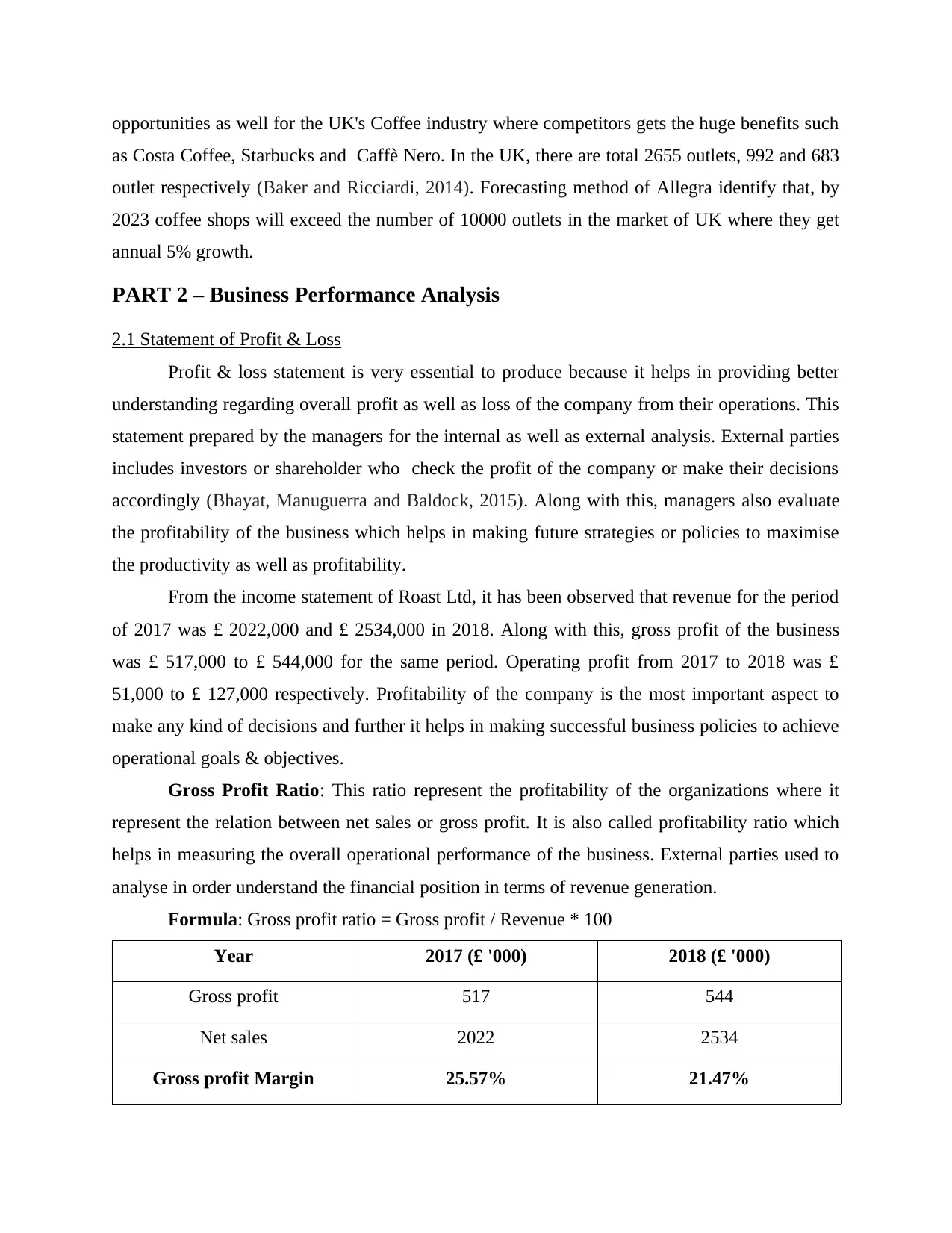
opportunities as well for the UK's Coffee industry where competitors gets the huge benefits such
as Costa Coffee, Starbucks and Caffè Nero. In the UK, there are total 2655 outlets, 992 and 683
outlet respectively (Baker and Ricciardi, 2014). Forecasting method of Allegra identify that, by
2023 coffee shops will exceed the number of 10000 outlets in the market of UK where they get
annual 5% growth.
PART 2 – Business Performance Analysis
2.1 Statement of Profit & Loss
Profit & loss statement is very essential to produce because it helps in providing better
understanding regarding overall profit as well as loss of the company from their operations. This
statement prepared by the managers for the internal as well as external analysis. External parties
includes investors or shareholder who check the profit of the company or make their decisions
accordingly (Bhayat, Manuguerra and Baldock, 2015). Along with this, managers also evaluate
the profitability of the business which helps in making future strategies or policies to maximise
the productivity as well as profitability.
From the income statement of Roast Ltd, it has been observed that revenue for the period
of 2017 was £ 2022,000 and £ 2534,000 in 2018. Along with this, gross profit of the business
was £ 517,000 to £ 544,000 for the same period. Operating profit from 2017 to 2018 was £
51,000 to £ 127,000 respectively. Profitability of the company is the most important aspect to
make any kind of decisions and further it helps in making successful business policies to achieve
operational goals & objectives.
Gross Profit Ratio: This ratio represent the profitability of the organizations where it
represent the relation between net sales or gross profit. It is also called profitability ratio which
helps in measuring the overall operational performance of the business. External parties used to
analyse in order understand the financial position in terms of revenue generation.
Formula: Gross profit ratio = Gross profit / Revenue * 100
Year 2017 (£ '000) 2018 (£ '000)
Gross profit 517 544
Net sales 2022 2534
Gross profit Margin 25.57% 21.47%
as Costa Coffee, Starbucks and Caffè Nero. In the UK, there are total 2655 outlets, 992 and 683
outlet respectively (Baker and Ricciardi, 2014). Forecasting method of Allegra identify that, by
2023 coffee shops will exceed the number of 10000 outlets in the market of UK where they get
annual 5% growth.
PART 2 – Business Performance Analysis
2.1 Statement of Profit & Loss
Profit & loss statement is very essential to produce because it helps in providing better
understanding regarding overall profit as well as loss of the company from their operations. This
statement prepared by the managers for the internal as well as external analysis. External parties
includes investors or shareholder who check the profit of the company or make their decisions
accordingly (Bhayat, Manuguerra and Baldock, 2015). Along with this, managers also evaluate
the profitability of the business which helps in making future strategies or policies to maximise
the productivity as well as profitability.
From the income statement of Roast Ltd, it has been observed that revenue for the period
of 2017 was £ 2022,000 and £ 2534,000 in 2018. Along with this, gross profit of the business
was £ 517,000 to £ 544,000 for the same period. Operating profit from 2017 to 2018 was £
51,000 to £ 127,000 respectively. Profitability of the company is the most important aspect to
make any kind of decisions and further it helps in making successful business policies to achieve
operational goals & objectives.
Gross Profit Ratio: This ratio represent the profitability of the organizations where it
represent the relation between net sales or gross profit. It is also called profitability ratio which
helps in measuring the overall operational performance of the business. External parties used to
analyse in order understand the financial position in terms of revenue generation.
Formula: Gross profit ratio = Gross profit / Revenue * 100
Year 2017 (£ '000) 2018 (£ '000)
Gross profit 517 544
Net sales 2022 2534
Gross profit Margin 25.57% 21.47%
Secure Best Marks with AI Grader
Need help grading? Try our AI Grader for instant feedback on your assignments.
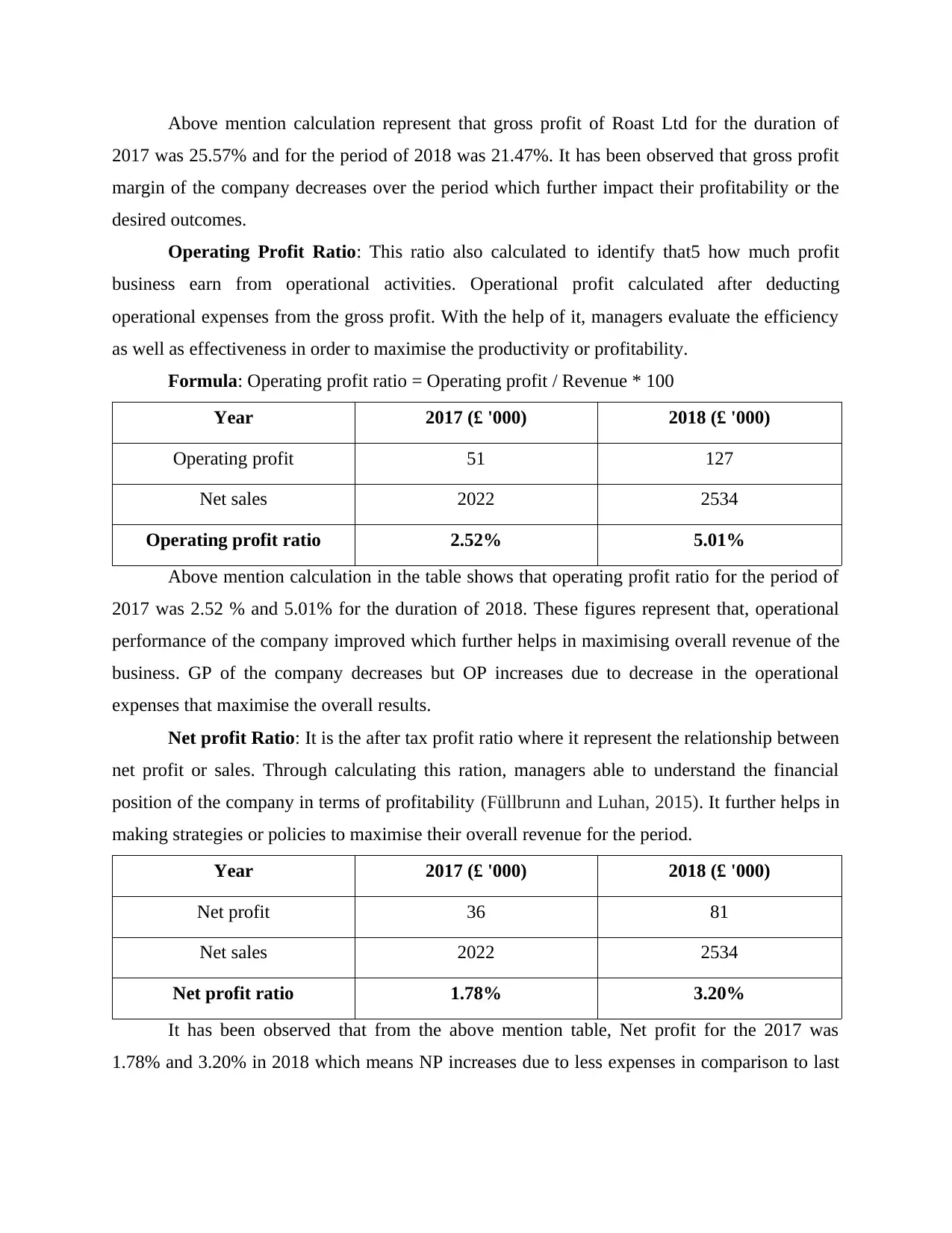
Above mention calculation represent that gross profit of Roast Ltd for the duration of
2017 was 25.57% and for the period of 2018 was 21.47%. It has been observed that gross profit
margin of the company decreases over the period which further impact their profitability or the
desired outcomes.
Operating Profit Ratio: This ratio also calculated to identify that5 how much profit
business earn from operational activities. Operational profit calculated after deducting
operational expenses from the gross profit. With the help of it, managers evaluate the efficiency
as well as effectiveness in order to maximise the productivity or profitability.
Formula: Operating profit ratio = Operating profit / Revenue * 100
Year 2017 (£ '000) 2018 (£ '000)
Operating profit 51 127
Net sales 2022 2534
Operating profit ratio 2.52% 5.01%
Above mention calculation in the table shows that operating profit ratio for the period of
2017 was 2.52 % and 5.01% for the duration of 2018. These figures represent that, operational
performance of the company improved which further helps in maximising overall revenue of the
business. GP of the company decreases but OP increases due to decrease in the operational
expenses that maximise the overall results.
Net profit Ratio: It is the after tax profit ratio where it represent the relationship between
net profit or sales. Through calculating this ration, managers able to understand the financial
position of the company in terms of profitability (Füllbrunn and Luhan, 2015). It further helps in
making strategies or policies to maximise their overall revenue for the period.
Year 2017 (£ '000) 2018 (£ '000)
Net profit 36 81
Net sales 2022 2534
Net profit ratio 1.78% 3.20%
It has been observed that from the above mention table, Net profit for the 2017 was
1.78% and 3.20% in 2018 which means NP increases due to less expenses in comparison to last
2017 was 25.57% and for the period of 2018 was 21.47%. It has been observed that gross profit
margin of the company decreases over the period which further impact their profitability or the
desired outcomes.
Operating Profit Ratio: This ratio also calculated to identify that5 how much profit
business earn from operational activities. Operational profit calculated after deducting
operational expenses from the gross profit. With the help of it, managers evaluate the efficiency
as well as effectiveness in order to maximise the productivity or profitability.
Formula: Operating profit ratio = Operating profit / Revenue * 100
Year 2017 (£ '000) 2018 (£ '000)
Operating profit 51 127
Net sales 2022 2534
Operating profit ratio 2.52% 5.01%
Above mention calculation in the table shows that operating profit ratio for the period of
2017 was 2.52 % and 5.01% for the duration of 2018. These figures represent that, operational
performance of the company improved which further helps in maximising overall revenue of the
business. GP of the company decreases but OP increases due to decrease in the operational
expenses that maximise the overall results.
Net profit Ratio: It is the after tax profit ratio where it represent the relationship between
net profit or sales. Through calculating this ration, managers able to understand the financial
position of the company in terms of profitability (Füllbrunn and Luhan, 2015). It further helps in
making strategies or policies to maximise their overall revenue for the period.
Year 2017 (£ '000) 2018 (£ '000)
Net profit 36 81
Net sales 2022 2534
Net profit ratio 1.78% 3.20%
It has been observed that from the above mention table, Net profit for the 2017 was
1.78% and 3.20% in 2018 which means NP increases due to less expenses in comparison to last
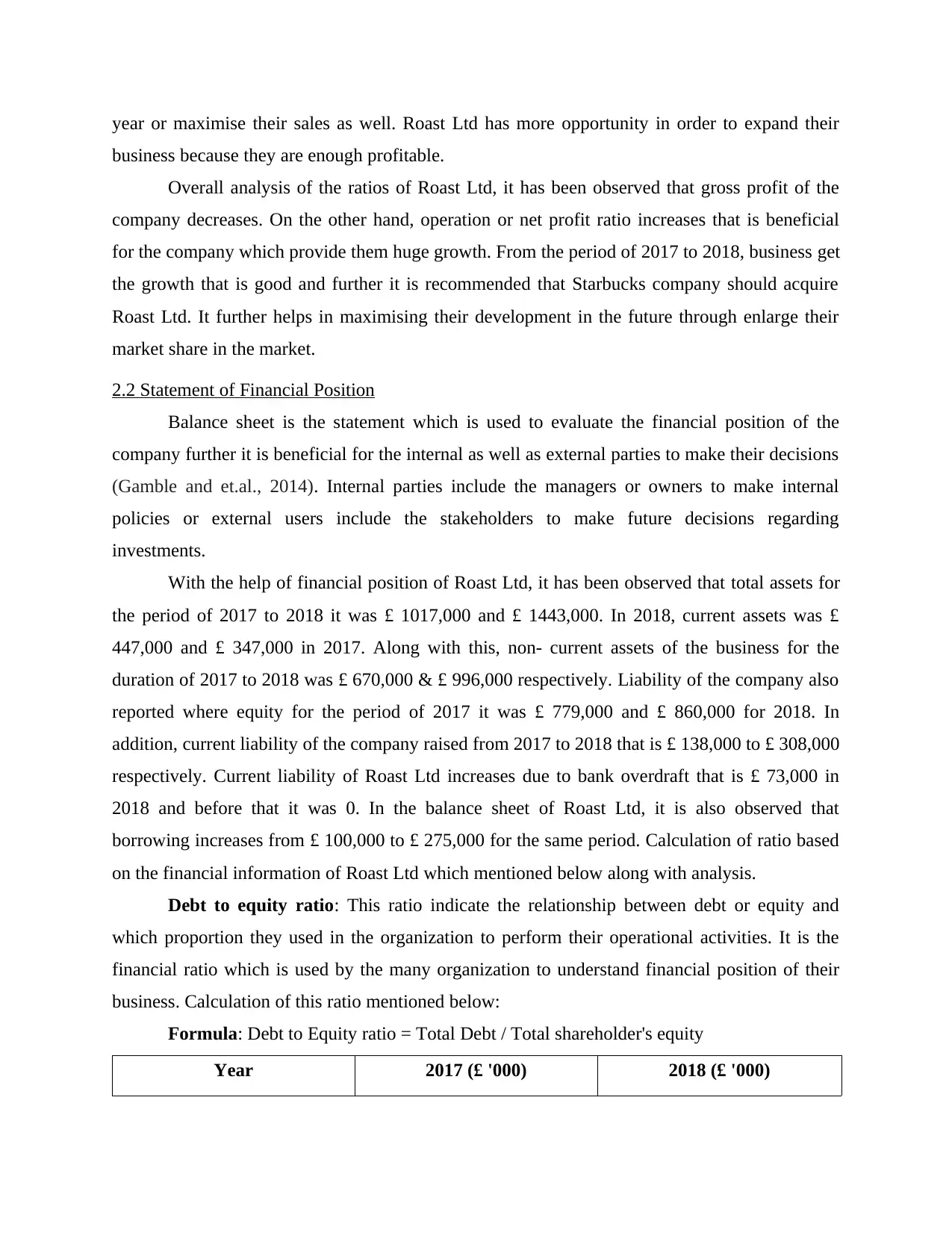
year or maximise their sales as well. Roast Ltd has more opportunity in order to expand their
business because they are enough profitable.
Overall analysis of the ratios of Roast Ltd, it has been observed that gross profit of the
company decreases. On the other hand, operation or net profit ratio increases that is beneficial
for the company which provide them huge growth. From the period of 2017 to 2018, business get
the growth that is good and further it is recommended that Starbucks company should acquire
Roast Ltd. It further helps in maximising their development in the future through enlarge their
market share in the market.
2.2 Statement of Financial Position
Balance sheet is the statement which is used to evaluate the financial position of the
company further it is beneficial for the internal as well as external parties to make their decisions
(Gamble and et.al., 2014). Internal parties include the managers or owners to make internal
policies or external users include the stakeholders to make future decisions regarding
investments.
With the help of financial position of Roast Ltd, it has been observed that total assets for
the period of 2017 to 2018 it was £ 1017,000 and £ 1443,000. In 2018, current assets was £
447,000 and £ 347,000 in 2017. Along with this, non- current assets of the business for the
duration of 2017 to 2018 was £ 670,000 & £ 996,000 respectively. Liability of the company also
reported where equity for the period of 2017 it was £ 779,000 and £ 860,000 for 2018. In
addition, current liability of the company raised from 2017 to 2018 that is £ 138,000 to £ 308,000
respectively. Current liability of Roast Ltd increases due to bank overdraft that is £ 73,000 in
2018 and before that it was 0. In the balance sheet of Roast Ltd, it is also observed that
borrowing increases from £ 100,000 to £ 275,000 for the same period. Calculation of ratio based
on the financial information of Roast Ltd which mentioned below along with analysis.
Debt to equity ratio: This ratio indicate the relationship between debt or equity and
which proportion they used in the organization to perform their operational activities. It is the
financial ratio which is used by the many organization to understand financial position of their
business. Calculation of this ratio mentioned below:
Formula: Debt to Equity ratio = Total Debt / Total shareholder's equity
Year 2017 (£ '000) 2018 (£ '000)
business because they are enough profitable.
Overall analysis of the ratios of Roast Ltd, it has been observed that gross profit of the
company decreases. On the other hand, operation or net profit ratio increases that is beneficial
for the company which provide them huge growth. From the period of 2017 to 2018, business get
the growth that is good and further it is recommended that Starbucks company should acquire
Roast Ltd. It further helps in maximising their development in the future through enlarge their
market share in the market.
2.2 Statement of Financial Position
Balance sheet is the statement which is used to evaluate the financial position of the
company further it is beneficial for the internal as well as external parties to make their decisions
(Gamble and et.al., 2014). Internal parties include the managers or owners to make internal
policies or external users include the stakeholders to make future decisions regarding
investments.
With the help of financial position of Roast Ltd, it has been observed that total assets for
the period of 2017 to 2018 it was £ 1017,000 and £ 1443,000. In 2018, current assets was £
447,000 and £ 347,000 in 2017. Along with this, non- current assets of the business for the
duration of 2017 to 2018 was £ 670,000 & £ 996,000 respectively. Liability of the company also
reported where equity for the period of 2017 it was £ 779,000 and £ 860,000 for 2018. In
addition, current liability of the company raised from 2017 to 2018 that is £ 138,000 to £ 308,000
respectively. Current liability of Roast Ltd increases due to bank overdraft that is £ 73,000 in
2018 and before that it was 0. In the balance sheet of Roast Ltd, it is also observed that
borrowing increases from £ 100,000 to £ 275,000 for the same period. Calculation of ratio based
on the financial information of Roast Ltd which mentioned below along with analysis.
Debt to equity ratio: This ratio indicate the relationship between debt or equity and
which proportion they used in the organization to perform their operational activities. It is the
financial ratio which is used by the many organization to understand financial position of their
business. Calculation of this ratio mentioned below:
Formula: Debt to Equity ratio = Total Debt / Total shareholder's equity
Year 2017 (£ '000) 2018 (£ '000)
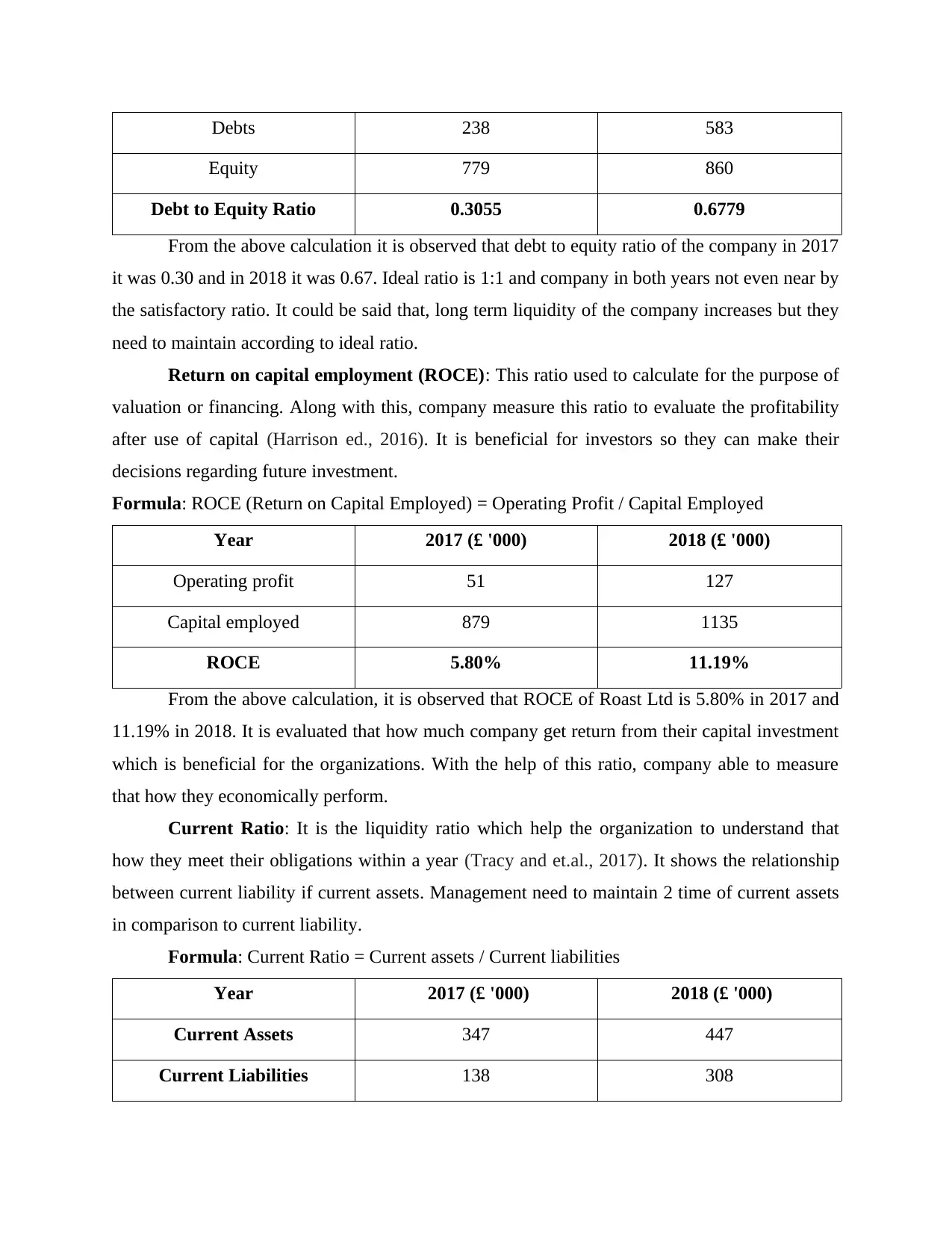
Debts 238 583
Equity 779 860
Debt to Equity Ratio 0.3055 0.6779
From the above calculation it is observed that debt to equity ratio of the company in 2017
it was 0.30 and in 2018 it was 0.67. Ideal ratio is 1:1 and company in both years not even near by
the satisfactory ratio. It could be said that, long term liquidity of the company increases but they
need to maintain according to ideal ratio.
Return on capital employment (ROCE): This ratio used to calculate for the purpose of
valuation or financing. Along with this, company measure this ratio to evaluate the profitability
after use of capital (Harrison ed., 2016). It is beneficial for investors so they can make their
decisions regarding future investment.
Formula: ROCE (Return on Capital Employed) = Operating Profit / Capital Employed
Year 2017 (£ '000) 2018 (£ '000)
Operating profit 51 127
Capital employed 879 1135
ROCE 5.80% 11.19%
From the above calculation, it is observed that ROCE of Roast Ltd is 5.80% in 2017 and
11.19% in 2018. It is evaluated that how much company get return from their capital investment
which is beneficial for the organizations. With the help of this ratio, company able to measure
that how they economically perform.
Current Ratio: It is the liquidity ratio which help the organization to understand that
how they meet their obligations within a year (Tracy and et.al., 2017). It shows the relationship
between current liability if current assets. Management need to maintain 2 time of current assets
in comparison to current liability.
Formula: Current Ratio = Current assets / Current liabilities
Year 2017 (£ '000) 2018 (£ '000)
Current Assets 347 447
Current Liabilities 138 308
Equity 779 860
Debt to Equity Ratio 0.3055 0.6779
From the above calculation it is observed that debt to equity ratio of the company in 2017
it was 0.30 and in 2018 it was 0.67. Ideal ratio is 1:1 and company in both years not even near by
the satisfactory ratio. It could be said that, long term liquidity of the company increases but they
need to maintain according to ideal ratio.
Return on capital employment (ROCE): This ratio used to calculate for the purpose of
valuation or financing. Along with this, company measure this ratio to evaluate the profitability
after use of capital (Harrison ed., 2016). It is beneficial for investors so they can make their
decisions regarding future investment.
Formula: ROCE (Return on Capital Employed) = Operating Profit / Capital Employed
Year 2017 (£ '000) 2018 (£ '000)
Operating profit 51 127
Capital employed 879 1135
ROCE 5.80% 11.19%
From the above calculation, it is observed that ROCE of Roast Ltd is 5.80% in 2017 and
11.19% in 2018. It is evaluated that how much company get return from their capital investment
which is beneficial for the organizations. With the help of this ratio, company able to measure
that how they economically perform.
Current Ratio: It is the liquidity ratio which help the organization to understand that
how they meet their obligations within a year (Tracy and et.al., 2017). It shows the relationship
between current liability if current assets. Management need to maintain 2 time of current assets
in comparison to current liability.
Formula: Current Ratio = Current assets / Current liabilities
Year 2017 (£ '000) 2018 (£ '000)
Current Assets 347 447
Current Liabilities 138 308
Paraphrase This Document
Need a fresh take? Get an instant paraphrase of this document with our AI Paraphraser
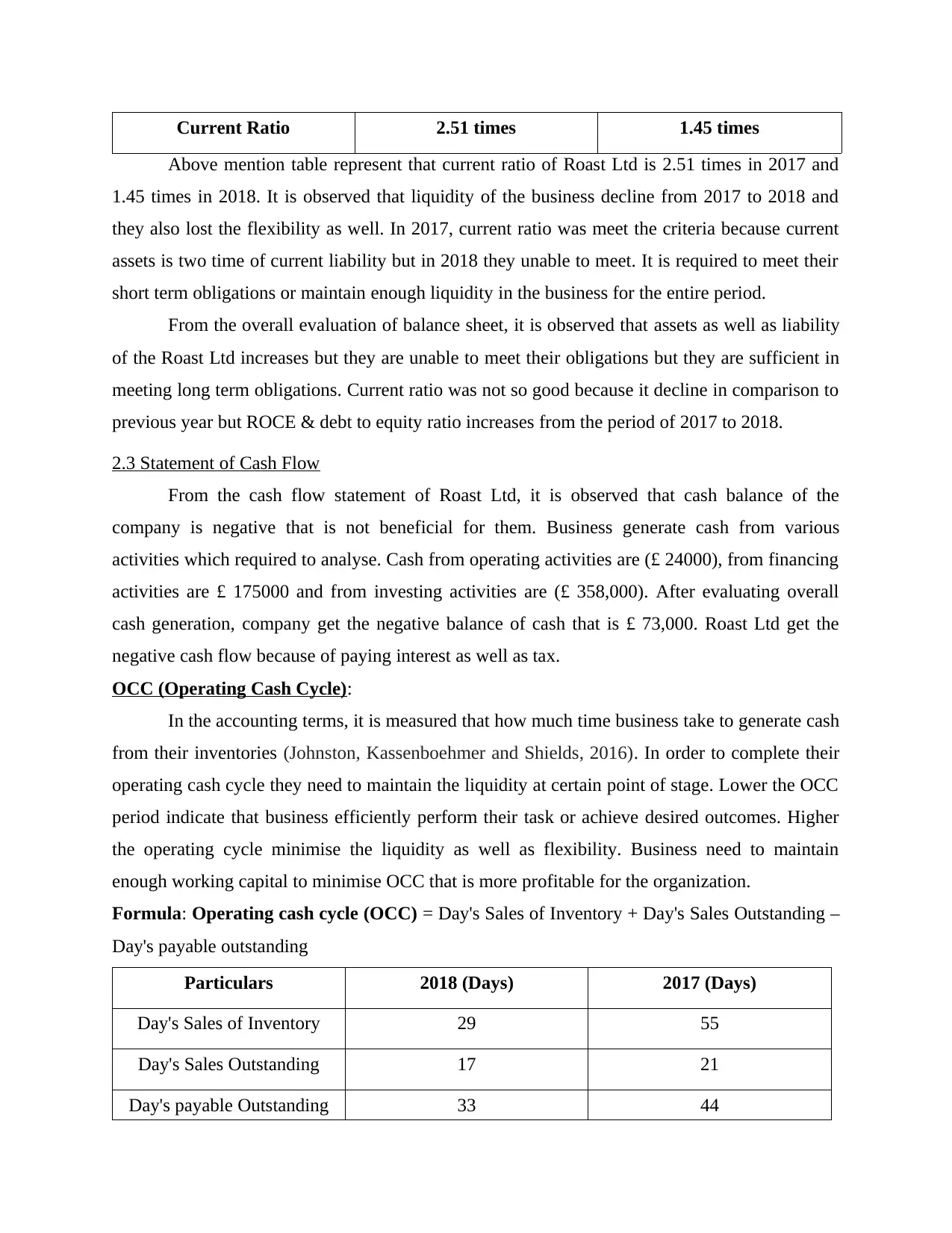
Current Ratio 2.51 times 1.45 times
Above mention table represent that current ratio of Roast Ltd is 2.51 times in 2017 and
1.45 times in 2018. It is observed that liquidity of the business decline from 2017 to 2018 and
they also lost the flexibility as well. In 2017, current ratio was meet the criteria because current
assets is two time of current liability but in 2018 they unable to meet. It is required to meet their
short term obligations or maintain enough liquidity in the business for the entire period.
From the overall evaluation of balance sheet, it is observed that assets as well as liability
of the Roast Ltd increases but they are unable to meet their obligations but they are sufficient in
meeting long term obligations. Current ratio was not so good because it decline in comparison to
previous year but ROCE & debt to equity ratio increases from the period of 2017 to 2018.
2.3 Statement of Cash Flow
From the cash flow statement of Roast Ltd, it is observed that cash balance of the
company is negative that is not beneficial for them. Business generate cash from various
activities which required to analyse. Cash from operating activities are (£ 24000), from financing
activities are £ 175000 and from investing activities are (£ 358,000). After evaluating overall
cash generation, company get the negative balance of cash that is £ 73,000. Roast Ltd get the
negative cash flow because of paying interest as well as tax.
OCC (Operating Cash Cycle):
In the accounting terms, it is measured that how much time business take to generate cash
from their inventories (Johnston, Kassenboehmer and Shields, 2016). In order to complete their
operating cash cycle they need to maintain the liquidity at certain point of stage. Lower the OCC
period indicate that business efficiently perform their task or achieve desired outcomes. Higher
the operating cycle minimise the liquidity as well as flexibility. Business need to maintain
enough working capital to minimise OCC that is more profitable for the organization.
Formula: Operating cash cycle (OCC) = Day's Sales of Inventory + Day's Sales Outstanding –
Day's payable outstanding
Particulars 2018 (Days) 2017 (Days)
Day's Sales of Inventory 29 55
Day's Sales Outstanding 17 21
Day's payable Outstanding 33 44
Above mention table represent that current ratio of Roast Ltd is 2.51 times in 2017 and
1.45 times in 2018. It is observed that liquidity of the business decline from 2017 to 2018 and
they also lost the flexibility as well. In 2017, current ratio was meet the criteria because current
assets is two time of current liability but in 2018 they unable to meet. It is required to meet their
short term obligations or maintain enough liquidity in the business for the entire period.
From the overall evaluation of balance sheet, it is observed that assets as well as liability
of the Roast Ltd increases but they are unable to meet their obligations but they are sufficient in
meeting long term obligations. Current ratio was not so good because it decline in comparison to
previous year but ROCE & debt to equity ratio increases from the period of 2017 to 2018.
2.3 Statement of Cash Flow
From the cash flow statement of Roast Ltd, it is observed that cash balance of the
company is negative that is not beneficial for them. Business generate cash from various
activities which required to analyse. Cash from operating activities are (£ 24000), from financing
activities are £ 175000 and from investing activities are (£ 358,000). After evaluating overall
cash generation, company get the negative balance of cash that is £ 73,000. Roast Ltd get the
negative cash flow because of paying interest as well as tax.
OCC (Operating Cash Cycle):
In the accounting terms, it is measured that how much time business take to generate cash
from their inventories (Johnston, Kassenboehmer and Shields, 2016). In order to complete their
operating cash cycle they need to maintain the liquidity at certain point of stage. Lower the OCC
period indicate that business efficiently perform their task or achieve desired outcomes. Higher
the operating cycle minimise the liquidity as well as flexibility. Business need to maintain
enough working capital to minimise OCC that is more profitable for the organization.
Formula: Operating cash cycle (OCC) = Day's Sales of Inventory + Day's Sales Outstanding –
Day's payable outstanding
Particulars 2018 (Days) 2017 (Days)
Day's Sales of Inventory 29 55
Day's Sales Outstanding 17 21
Day's payable Outstanding 33 44
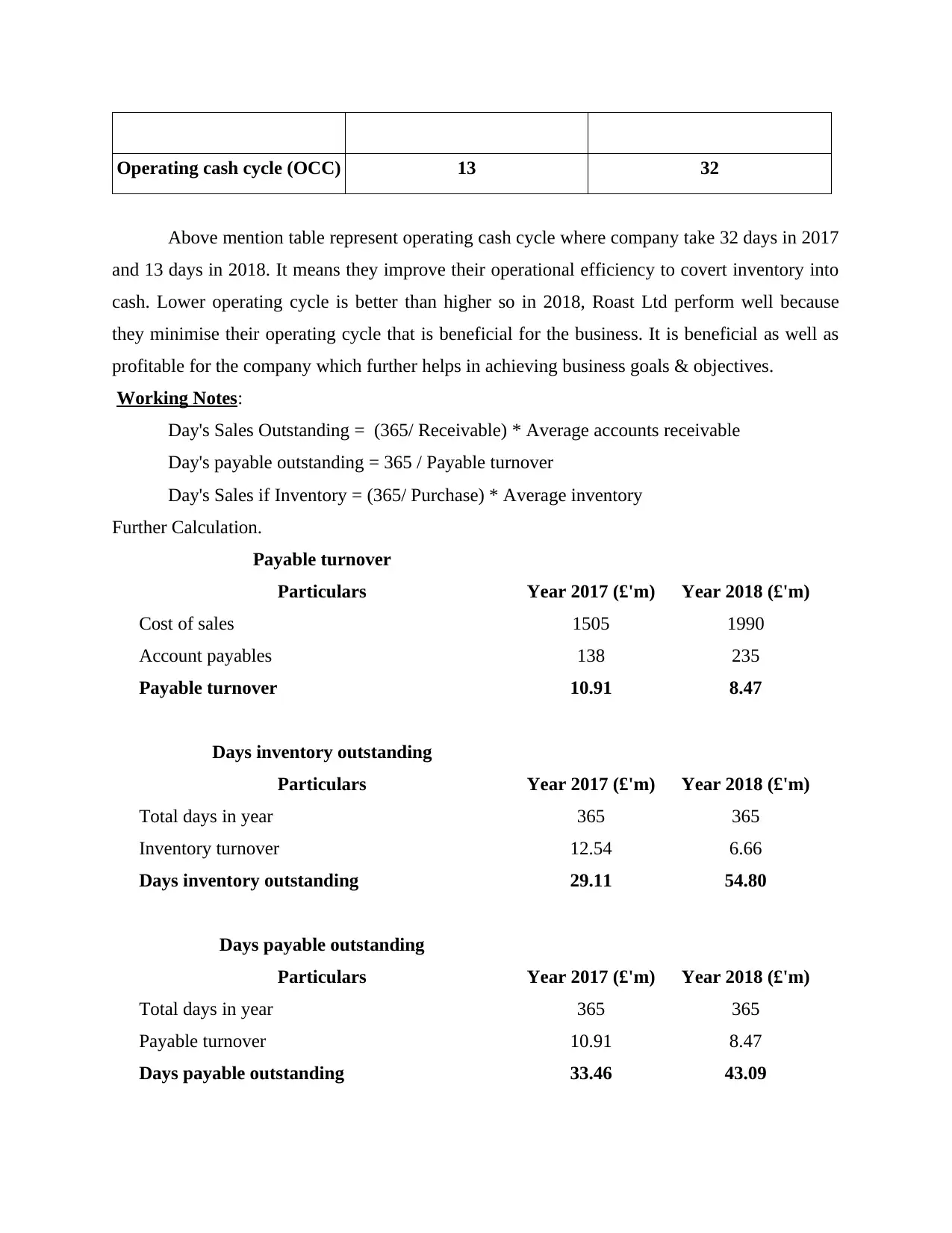
Operating cash cycle (OCC) 13 32
Above mention table represent operating cash cycle where company take 32 days in 2017
and 13 days in 2018. It means they improve their operational efficiency to covert inventory into
cash. Lower operating cycle is better than higher so in 2018, Roast Ltd perform well because
they minimise their operating cycle that is beneficial for the business. It is beneficial as well as
profitable for the company which further helps in achieving business goals & objectives.
Working Notes:
Day's Sales Outstanding = (365/ Receivable) * Average accounts receivable
Day's payable outstanding = 365 / Payable turnover
Day's Sales if Inventory = (365/ Purchase) * Average inventory
Further Calculation.
Payable turnover
Particulars Year 2017 (£'m) Year 2018 (£'m)
Cost of sales 1505 1990
Account payables 138 235
Payable turnover 10.91 8.47
Days inventory outstanding
Particulars Year 2017 (£'m) Year 2018 (£'m)
Total days in year 365 365
Inventory turnover 12.54 6.66
Days inventory outstanding 29.11 54.80
Days payable outstanding
Particulars Year 2017 (£'m) Year 2018 (£'m)
Total days in year 365 365
Payable turnover 10.91 8.47
Days payable outstanding 33.46 43.09
Above mention table represent operating cash cycle where company take 32 days in 2017
and 13 days in 2018. It means they improve their operational efficiency to covert inventory into
cash. Lower operating cycle is better than higher so in 2018, Roast Ltd perform well because
they minimise their operating cycle that is beneficial for the business. It is beneficial as well as
profitable for the company which further helps in achieving business goals & objectives.
Working Notes:
Day's Sales Outstanding = (365/ Receivable) * Average accounts receivable
Day's payable outstanding = 365 / Payable turnover
Day's Sales if Inventory = (365/ Purchase) * Average inventory
Further Calculation.
Payable turnover
Particulars Year 2017 (£'m) Year 2018 (£'m)
Cost of sales 1505 1990
Account payables 138 235
Payable turnover 10.91 8.47
Days inventory outstanding
Particulars Year 2017 (£'m) Year 2018 (£'m)
Total days in year 365 365
Inventory turnover 12.54 6.66
Days inventory outstanding 29.11 54.80
Days payable outstanding
Particulars Year 2017 (£'m) Year 2018 (£'m)
Total days in year 365 365
Payable turnover 10.91 8.47
Days payable outstanding 33.46 43.09
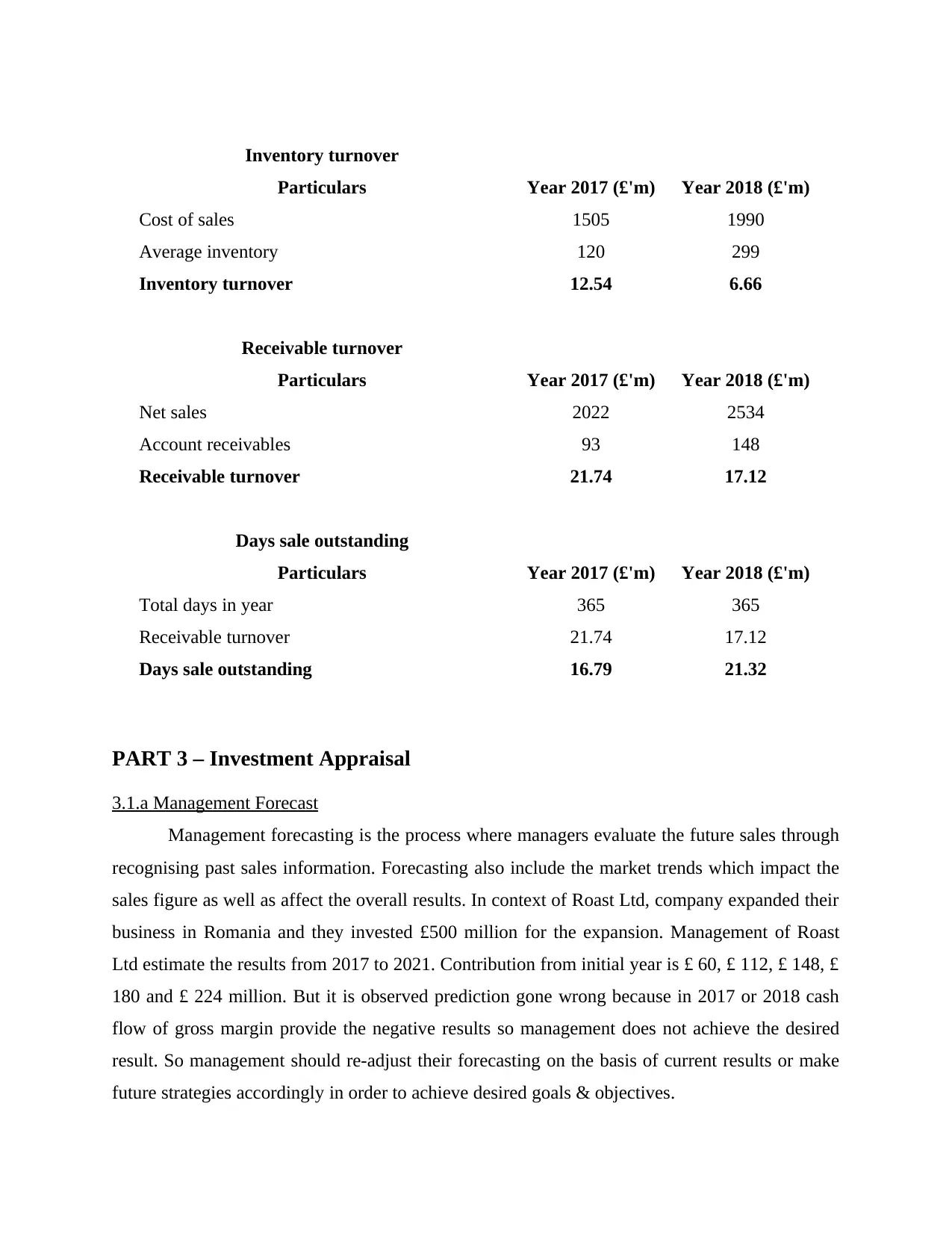
Inventory turnover
Particulars Year 2017 (£'m) Year 2018 (£'m)
Cost of sales 1505 1990
Average inventory 120 299
Inventory turnover 12.54 6.66
Receivable turnover
Particulars Year 2017 (£'m) Year 2018 (£'m)
Net sales 2022 2534
Account receivables 93 148
Receivable turnover 21.74 17.12
Days sale outstanding
Particulars Year 2017 (£'m) Year 2018 (£'m)
Total days in year 365 365
Receivable turnover 21.74 17.12
Days sale outstanding 16.79 21.32
PART 3 – Investment Appraisal
3.1.a Management Forecast
Management forecasting is the process where managers evaluate the future sales through
recognising past sales information. Forecasting also include the market trends which impact the
sales figure as well as affect the overall results. In context of Roast Ltd, company expanded their
business in Romania and they invested £500 million for the expansion. Management of Roast
Ltd estimate the results from 2017 to 2021. Contribution from initial year is £ 60, £ 112, £ 148, £
180 and £ 224 million. But it is observed prediction gone wrong because in 2017 or 2018 cash
flow of gross margin provide the negative results so management does not achieve the desired
result. So management should re-adjust their forecasting on the basis of current results or make
future strategies accordingly in order to achieve desired goals & objectives.
Particulars Year 2017 (£'m) Year 2018 (£'m)
Cost of sales 1505 1990
Average inventory 120 299
Inventory turnover 12.54 6.66
Receivable turnover
Particulars Year 2017 (£'m) Year 2018 (£'m)
Net sales 2022 2534
Account receivables 93 148
Receivable turnover 21.74 17.12
Days sale outstanding
Particulars Year 2017 (£'m) Year 2018 (£'m)
Total days in year 365 365
Receivable turnover 21.74 17.12
Days sale outstanding 16.79 21.32
PART 3 – Investment Appraisal
3.1.a Management Forecast
Management forecasting is the process where managers evaluate the future sales through
recognising past sales information. Forecasting also include the market trends which impact the
sales figure as well as affect the overall results. In context of Roast Ltd, company expanded their
business in Romania and they invested £500 million for the expansion. Management of Roast
Ltd estimate the results from 2017 to 2021. Contribution from initial year is £ 60, £ 112, £ 148, £
180 and £ 224 million. But it is observed prediction gone wrong because in 2017 or 2018 cash
flow of gross margin provide the negative results so management does not achieve the desired
result. So management should re-adjust their forecasting on the basis of current results or make
future strategies accordingly in order to achieve desired goals & objectives.
Secure Best Marks with AI Grader
Need help grading? Try our AI Grader for instant feedback on your assignments.
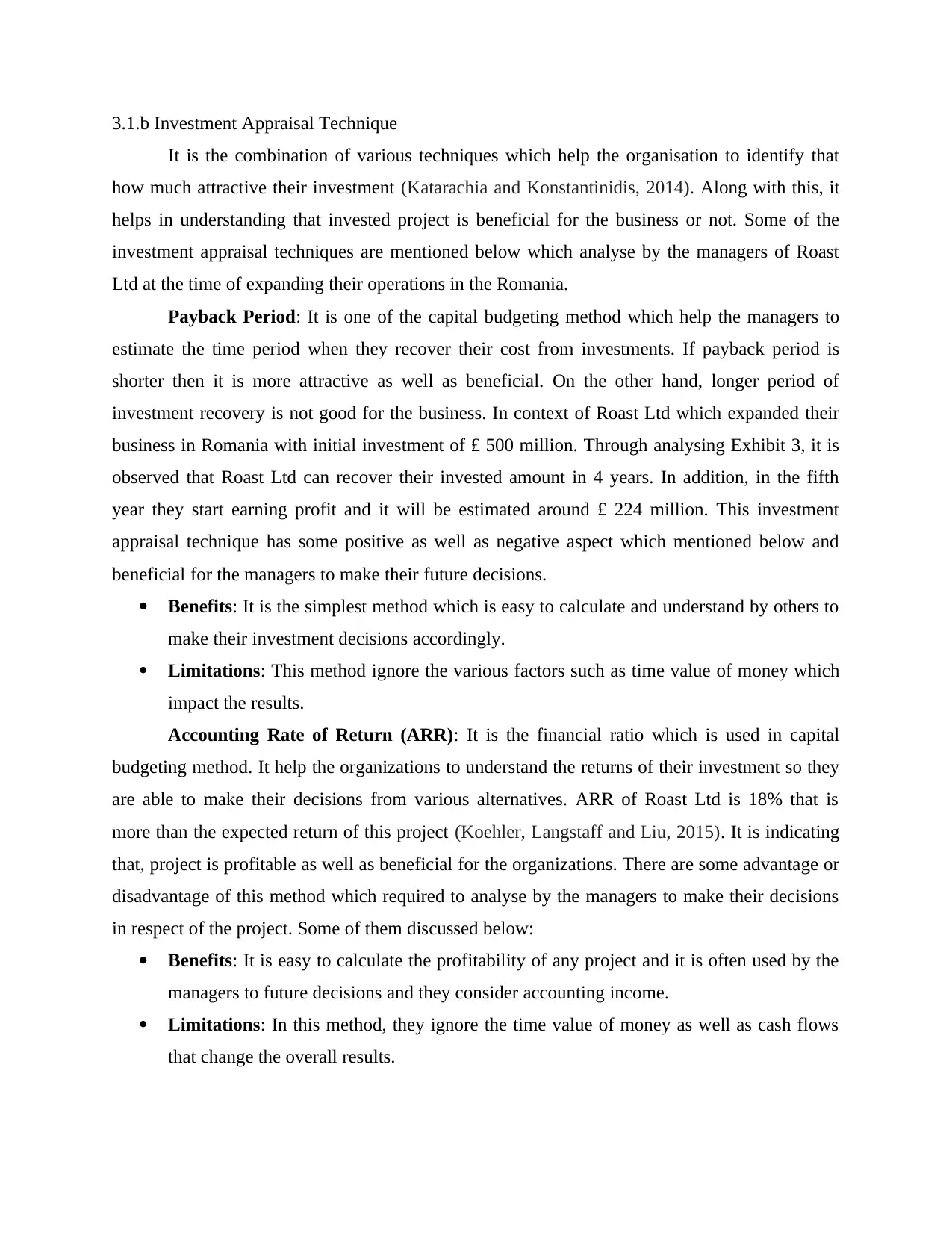
3.1.b Investment Appraisal Technique
It is the combination of various techniques which help the organisation to identify that
how much attractive their investment (Katarachia and Konstantinidis, 2014). Along with this, it
helps in understanding that invested project is beneficial for the business or not. Some of the
investment appraisal techniques are mentioned below which analyse by the managers of Roast
Ltd at the time of expanding their operations in the Romania.
Payback Period: It is one of the capital budgeting method which help the managers to
estimate the time period when they recover their cost from investments. If payback period is
shorter then it is more attractive as well as beneficial. On the other hand, longer period of
investment recovery is not good for the business. In context of Roast Ltd which expanded their
business in Romania with initial investment of £ 500 million. Through analysing Exhibit 3, it is
observed that Roast Ltd can recover their invested amount in 4 years. In addition, in the fifth
year they start earning profit and it will be estimated around £ 224 million. This investment
appraisal technique has some positive as well as negative aspect which mentioned below and
beneficial for the managers to make their future decisions.
Benefits: It is the simplest method which is easy to calculate and understand by others to
make their investment decisions accordingly.
Limitations: This method ignore the various factors such as time value of money which
impact the results.
Accounting Rate of Return (ARR): It is the financial ratio which is used in capital
budgeting method. It help the organizations to understand the returns of their investment so they
are able to make their decisions from various alternatives. ARR of Roast Ltd is 18% that is
more than the expected return of this project (Koehler, Langstaff and Liu, 2015). It is indicating
that, project is profitable as well as beneficial for the organizations. There are some advantage or
disadvantage of this method which required to analyse by the managers to make their decisions
in respect of the project. Some of them discussed below:
Benefits: It is easy to calculate the profitability of any project and it is often used by the
managers to future decisions and they consider accounting income.
Limitations: In this method, they ignore the time value of money as well as cash flows
that change the overall results.
It is the combination of various techniques which help the organisation to identify that
how much attractive their investment (Katarachia and Konstantinidis, 2014). Along with this, it
helps in understanding that invested project is beneficial for the business or not. Some of the
investment appraisal techniques are mentioned below which analyse by the managers of Roast
Ltd at the time of expanding their operations in the Romania.
Payback Period: It is one of the capital budgeting method which help the managers to
estimate the time period when they recover their cost from investments. If payback period is
shorter then it is more attractive as well as beneficial. On the other hand, longer period of
investment recovery is not good for the business. In context of Roast Ltd which expanded their
business in Romania with initial investment of £ 500 million. Through analysing Exhibit 3, it is
observed that Roast Ltd can recover their invested amount in 4 years. In addition, in the fifth
year they start earning profit and it will be estimated around £ 224 million. This investment
appraisal technique has some positive as well as negative aspect which mentioned below and
beneficial for the managers to make their future decisions.
Benefits: It is the simplest method which is easy to calculate and understand by others to
make their investment decisions accordingly.
Limitations: This method ignore the various factors such as time value of money which
impact the results.
Accounting Rate of Return (ARR): It is the financial ratio which is used in capital
budgeting method. It help the organizations to understand the returns of their investment so they
are able to make their decisions from various alternatives. ARR of Roast Ltd is 18% that is
more than the expected return of this project (Koehler, Langstaff and Liu, 2015). It is indicating
that, project is profitable as well as beneficial for the organizations. There are some advantage or
disadvantage of this method which required to analyse by the managers to make their decisions
in respect of the project. Some of them discussed below:
Benefits: It is easy to calculate the profitability of any project and it is often used by the
managers to future decisions and they consider accounting income.
Limitations: In this method, they ignore the time value of money as well as cash flows
that change the overall results.

Net Present Value (NPV): This technique applicable on the different cash flows from
the different time period. Current value of cash flow is totally depend upon the time interval
between the cash flows of the investment (Koropp and et.al., 2014). NPV help the business to
choose the most profitable option for investment where positive NPV is beneficial for the
organizations. NPV of Romania project is £ 110 million where discounting rate is 5%. So it is
observed that value of NPV is positive which is beneficial as well as profitable investment for
Roast Ltd. This appraisal techniques has some benefits as well as limitations which is mentioned
below:
Benefits: This investment appraisal technique include the time value of money, it is easy
to understand and here does not consider the negative NPV because future cash flows are
positive.
Limitations: NPV is based on the discounted rate which can vary the final outcomes and
it is based on the estimated cash flows of the projects.
3.2 Sources of Finance
Finance required by the organization in order to meet their short term as well as long term
requirement of their business operations (Lu, Won and Cheng, 2016). In order to complete day to
day transaction management required funds from various sources. Some of them discussed
below:
Banks: It is the financial institute which provide the funds to the individual as well as
organizations to meet their short term as well as long term requirements. In order to complete
their day to day activities business has to maintain enough working capital (Seshan and Yang,
2014). So organizations take loan from banks as per the requirement of their operations. In order
to expand their business in Romania, Roast Ltd can use this sources for financing or execute the
activities to achieve their goals & objectives. Some of advantage & disadvantage mentioned
below:
Advantage: It is the easiest way to getting loan where banks provide loans on low rate of
interest against the security which is any fixed assets.
Disadvantage: Loan amount can be limited because it will depend upon the value of
security which they deposit against the loan (Martin and Gomez-Mejia, 2016).
Equity: In this sources of finance company sell their securities or stocks in the market in
order to raise funds. It is one of the major sources of finance where they generate money for
the different time period. Current value of cash flow is totally depend upon the time interval
between the cash flows of the investment (Koropp and et.al., 2014). NPV help the business to
choose the most profitable option for investment where positive NPV is beneficial for the
organizations. NPV of Romania project is £ 110 million where discounting rate is 5%. So it is
observed that value of NPV is positive which is beneficial as well as profitable investment for
Roast Ltd. This appraisal techniques has some benefits as well as limitations which is mentioned
below:
Benefits: This investment appraisal technique include the time value of money, it is easy
to understand and here does not consider the negative NPV because future cash flows are
positive.
Limitations: NPV is based on the discounted rate which can vary the final outcomes and
it is based on the estimated cash flows of the projects.
3.2 Sources of Finance
Finance required by the organization in order to meet their short term as well as long term
requirement of their business operations (Lu, Won and Cheng, 2016). In order to complete day to
day transaction management required funds from various sources. Some of them discussed
below:
Banks: It is the financial institute which provide the funds to the individual as well as
organizations to meet their short term as well as long term requirements. In order to complete
their day to day activities business has to maintain enough working capital (Seshan and Yang,
2014). So organizations take loan from banks as per the requirement of their operations. In order
to expand their business in Romania, Roast Ltd can use this sources for financing or execute the
activities to achieve their goals & objectives. Some of advantage & disadvantage mentioned
below:
Advantage: It is the easiest way to getting loan where banks provide loans on low rate of
interest against the security which is any fixed assets.
Disadvantage: Loan amount can be limited because it will depend upon the value of
security which they deposit against the loan (Martin and Gomez-Mejia, 2016).
Equity: In this sources of finance company sell their securities or stocks in the market in
order to raise funds. It is one of the major sources of finance where they generate money for
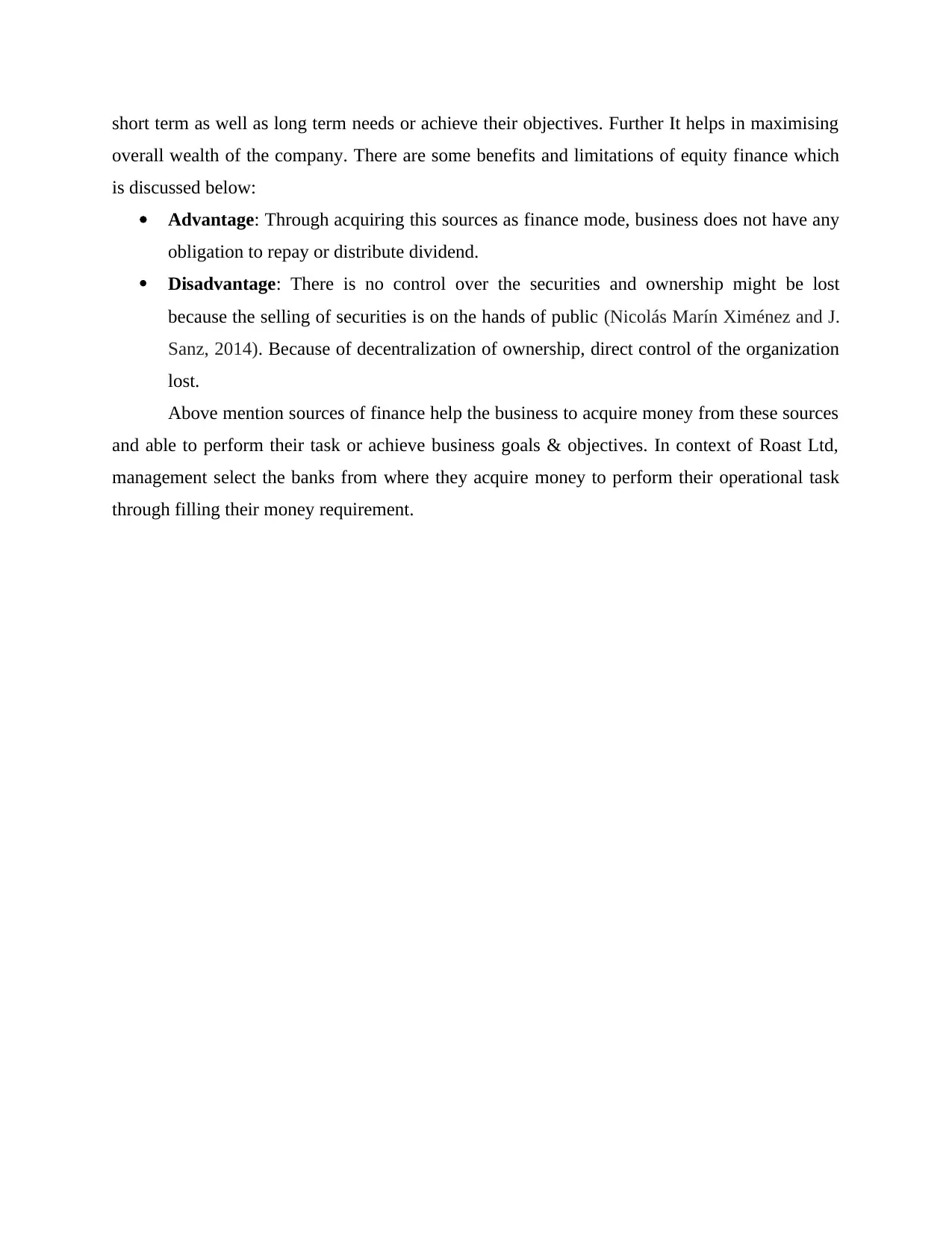
short term as well as long term needs or achieve their objectives. Further It helps in maximising
overall wealth of the company. There are some benefits and limitations of equity finance which
is discussed below:
Advantage: Through acquiring this sources as finance mode, business does not have any
obligation to repay or distribute dividend.
Disadvantage: There is no control over the securities and ownership might be lost
because the selling of securities is on the hands of public (Nicolás Marín Ximénez and J.
Sanz, 2014). Because of decentralization of ownership, direct control of the organization
lost.
Above mention sources of finance help the business to acquire money from these sources
and able to perform their task or achieve business goals & objectives. In context of Roast Ltd,
management select the banks from where they acquire money to perform their operational task
through filling their money requirement.
overall wealth of the company. There are some benefits and limitations of equity finance which
is discussed below:
Advantage: Through acquiring this sources as finance mode, business does not have any
obligation to repay or distribute dividend.
Disadvantage: There is no control over the securities and ownership might be lost
because the selling of securities is on the hands of public (Nicolás Marín Ximénez and J.
Sanz, 2014). Because of decentralization of ownership, direct control of the organization
lost.
Above mention sources of finance help the business to acquire money from these sources
and able to perform their task or achieve business goals & objectives. In context of Roast Ltd,
management select the banks from where they acquire money to perform their operational task
through filling their money requirement.
Paraphrase This Document
Need a fresh take? Get an instant paraphrase of this document with our AI Paraphraser
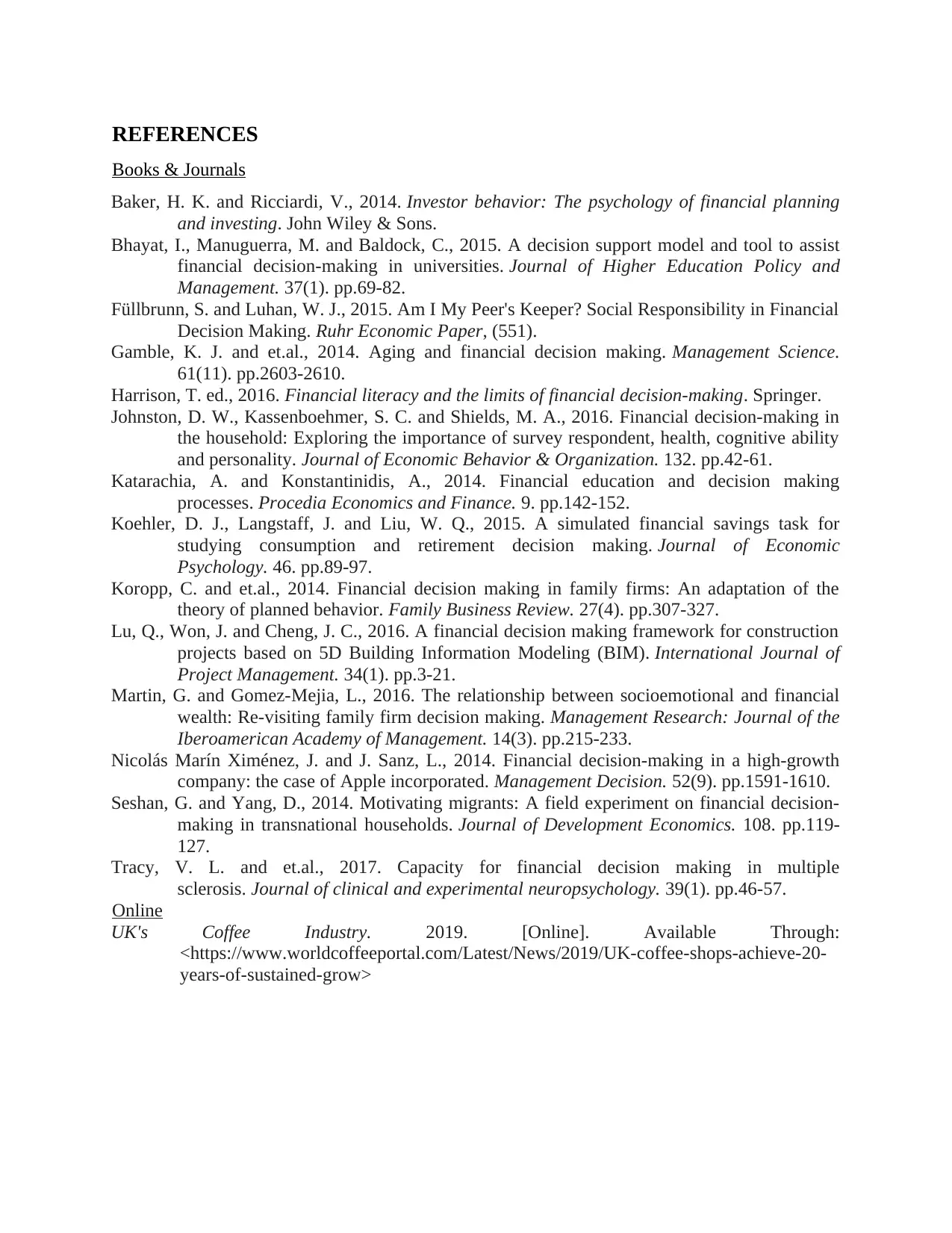
REFERENCES
Books & Journals
Baker, H. K. and Ricciardi, V., 2014. Investor behavior: The psychology of financial planning
and investing. John Wiley & Sons.
Bhayat, I., Manuguerra, M. and Baldock, C., 2015. A decision support model and tool to assist
financial decision-making in universities. Journal of Higher Education Policy and
Management. 37(1). pp.69-82.
Füllbrunn, S. and Luhan, W. J., 2015. Am I My Peer's Keeper? Social Responsibility in Financial
Decision Making. Ruhr Economic Paper, (551).
Gamble, K. J. and et.al., 2014. Aging and financial decision making. Management Science.
61(11). pp.2603-2610.
Harrison, T. ed., 2016. Financial literacy and the limits of financial decision-making. Springer.
Johnston, D. W., Kassenboehmer, S. C. and Shields, M. A., 2016. Financial decision-making in
the household: Exploring the importance of survey respondent, health, cognitive ability
and personality. Journal of Economic Behavior & Organization. 132. pp.42-61.
Katarachia, A. and Konstantinidis, A., 2014. Financial education and decision making
processes. Procedia Economics and Finance. 9. pp.142-152.
Koehler, D. J., Langstaff, J. and Liu, W. Q., 2015. A simulated financial savings task for
studying consumption and retirement decision making. Journal of Economic
Psychology. 46. pp.89-97.
Koropp, C. and et.al., 2014. Financial decision making in family firms: An adaptation of the
theory of planned behavior. Family Business Review. 27(4). pp.307-327.
Lu, Q., Won, J. and Cheng, J. C., 2016. A financial decision making framework for construction
projects based on 5D Building Information Modeling (BIM). International Journal of
Project Management. 34(1). pp.3-21.
Martin, G. and Gomez-Mejia, L., 2016. The relationship between socioemotional and financial
wealth: Re-visiting family firm decision making. Management Research: Journal of the
Iberoamerican Academy of Management. 14(3). pp.215-233.
Nicolás Marín Ximénez, J. and J. Sanz, L., 2014. Financial decision-making in a high-growth
company: the case of Apple incorporated. Management Decision. 52(9). pp.1591-1610.
Seshan, G. and Yang, D., 2014. Motivating migrants: A field experiment on financial decision-
making in transnational households. Journal of Development Economics. 108. pp.119-
127.
Tracy, V. L. and et.al., 2017. Capacity for financial decision making in multiple
sclerosis. Journal of clinical and experimental neuropsychology. 39(1). pp.46-57.
Online
UK's Coffee Industry. 2019. [Online]. Available Through:
<https://www.worldcoffeeportal.com/Latest/News/2019/UK-coffee-shops-achieve-20-
years-of-sustained-grow>
Books & Journals
Baker, H. K. and Ricciardi, V., 2014. Investor behavior: The psychology of financial planning
and investing. John Wiley & Sons.
Bhayat, I., Manuguerra, M. and Baldock, C., 2015. A decision support model and tool to assist
financial decision-making in universities. Journal of Higher Education Policy and
Management. 37(1). pp.69-82.
Füllbrunn, S. and Luhan, W. J., 2015. Am I My Peer's Keeper? Social Responsibility in Financial
Decision Making. Ruhr Economic Paper, (551).
Gamble, K. J. and et.al., 2014. Aging and financial decision making. Management Science.
61(11). pp.2603-2610.
Harrison, T. ed., 2016. Financial literacy and the limits of financial decision-making. Springer.
Johnston, D. W., Kassenboehmer, S. C. and Shields, M. A., 2016. Financial decision-making in
the household: Exploring the importance of survey respondent, health, cognitive ability
and personality. Journal of Economic Behavior & Organization. 132. pp.42-61.
Katarachia, A. and Konstantinidis, A., 2014. Financial education and decision making
processes. Procedia Economics and Finance. 9. pp.142-152.
Koehler, D. J., Langstaff, J. and Liu, W. Q., 2015. A simulated financial savings task for
studying consumption and retirement decision making. Journal of Economic
Psychology. 46. pp.89-97.
Koropp, C. and et.al., 2014. Financial decision making in family firms: An adaptation of the
theory of planned behavior. Family Business Review. 27(4). pp.307-327.
Lu, Q., Won, J. and Cheng, J. C., 2016. A financial decision making framework for construction
projects based on 5D Building Information Modeling (BIM). International Journal of
Project Management. 34(1). pp.3-21.
Martin, G. and Gomez-Mejia, L., 2016. The relationship between socioemotional and financial
wealth: Re-visiting family firm decision making. Management Research: Journal of the
Iberoamerican Academy of Management. 14(3). pp.215-233.
Nicolás Marín Ximénez, J. and J. Sanz, L., 2014. Financial decision-making in a high-growth
company: the case of Apple incorporated. Management Decision. 52(9). pp.1591-1610.
Seshan, G. and Yang, D., 2014. Motivating migrants: A field experiment on financial decision-
making in transnational households. Journal of Development Economics. 108. pp.119-
127.
Tracy, V. L. and et.al., 2017. Capacity for financial decision making in multiple
sclerosis. Journal of clinical and experimental neuropsychology. 39(1). pp.46-57.
Online
UK's Coffee Industry. 2019. [Online]. Available Through:
<https://www.worldcoffeeportal.com/Latest/News/2019/UK-coffee-shops-achieve-20-
years-of-sustained-grow>
1 out of 14
Related Documents
Your All-in-One AI-Powered Toolkit for Academic Success.
+13062052269
info@desklib.com
Available 24*7 on WhatsApp / Email
![[object Object]](/_next/static/media/star-bottom.7253800d.svg)
Unlock your academic potential
© 2024 | Zucol Services PVT LTD | All rights reserved.





